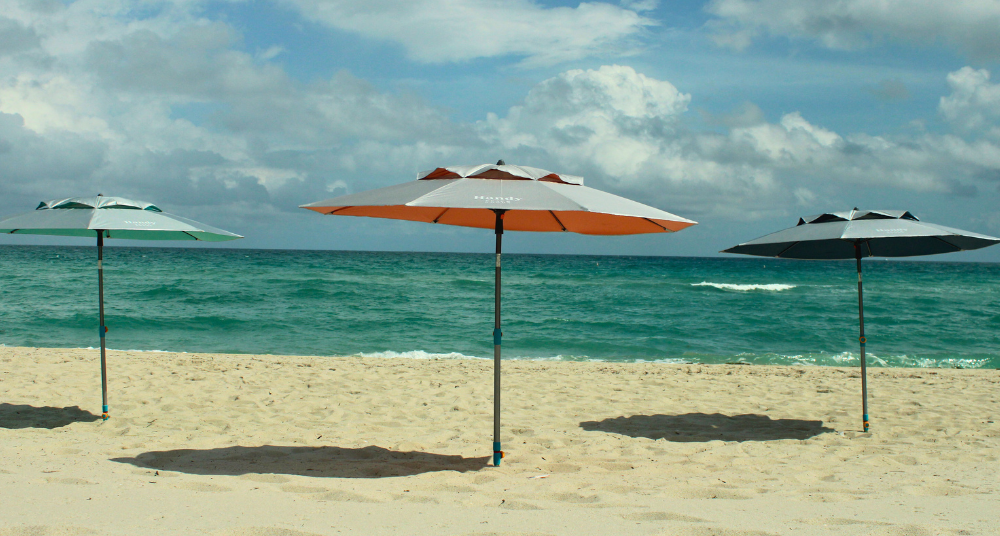30-Second Summary: Not all beach umbrellas are created equal. Most are not safety tested and will fail in high wind. This guide explains the 6 key factors to look for: 1) Certified Wind Safety (the ASTM F3681-24 standard), 2) A deep-setting Anchor System, 3) True Sun Protection (UPF 55+), 4) Durable Materials (fiberglass ribs & RPET), 5) Proper Size, and 6) Brand Trust. Don't risk your safety—buy an umbrella that's engineered to work.
A beach umbrella seems like a simple purchase—until the first gust of wind turns it into a dangerous, tumbling spear. We’ve all seen it: the panicked chase down the beach, or worse, the tragic accidents that make the news.
The hard truth is that most beach umbrellas are not designed to handle real coastal wind. The U.S. Consumer Product Safety Commission (CPSC) estimates that over 3,000 people are sent to the emergency room by beach umbrella injuries each year.
As product engineers and Florida-based parents, this problem is what inspired us to found Handy Beach Goods. We didn't just want to sell another umbrella; we wanted to engineer a solution.
This guide will teach you what to look for, from the new official safety standard to the one anchor type that actually works. If you're planning a trip, we also recommend our Ultimate Beach Packing Checklist for a complete overview of all your gear.
Factor 1: Wind Resistance & The ASTM Safety Standard
This is the single most important factor. An umbrella that can't handle a gust of wind is not just a waste of money; it's a liability. For years, "wind-resistant" was just a marketing term. Not anymore.
There is now an official safety standard: ASTM F3681-24.
This standard was developed by ASTM International with help from CPSC engineers to finally create an objective test for beach umbrella safety. It sets performance requirements for an umbrella's ability to stay anchored in windy conditions, typically tested in a wind tunnel at speeds up to 30 mph.
Want to see how these safety features perform in the real world? We put the top brands to the test. Read our head-to-head review: Best Beach Umbrella for Wind: Handy vs. Tommy Bahama & beachBUB.
Your takeaway: Before you buy, ask one question: "Is it independently tested to the ASTM F3681-24 standard?" If the answer is no, you are buying a product that has not been verified for safety in high wind. The Handy Beach Umbrella is one of the very few that proudly passes this rigorous test.
Factor 2: The Anchoring System
An umbrella's wind resistance is only as good as its anchor. The ASTM test findings were clear: traditional methods are not effective.
Twist-in Screws / Augers
This is the most common type of "anchor." Unfortunately, CPSC and ASTM testing found that simple twist-in screws are **not effective** in preventing flyaway accidents. They simply don't have the grip in dry, loose sand to hold against a powerful gust.
Sandbags
Sandbag systems (like the beachBUB) work by using weight (often 75+ lbs of sand) to hold the umbrella down. They are effective and pass the ASTM test. The major drawback is convenience: they are heavy, messy, and require significant setup time.
Deep-Set Hammering Anchors
This is the system we engineered for the Handy Beach Anchor. Instead of twisting or relying on weight, it uses a built-in hammering mechanism to drive a 2-foot steel stake deep into the sand—in just 10 seconds. This provides a deep, secure hold (like a tent stake) without the time, mess, or heavy lifting.
Your takeaway: For a full breakdown of how these anchor types perform, read our complete Sand Anchor Comparison Guide.
Factor 3: Sun Protection (What UPF 55+ Really Means)
The second job of an umbrella is shade. But not all shade provides equal sun protection.[4] A cheap, thin canopy might only have a UPF (Ultraviolet Protection Factor) of 5, offering minimal protection.
- UPF Rating: This measures how much of the sun's UV radiation is blocked. The Skin Cancer Foundation considers UPF 50+ to be "Excellent," as it blocks 98% or more of UV rays.
- Silver-Lining (Heat-Reflective): A standard dark canopy absorbs heat. A silver-lined canopy (like the one on the Handy Beach Umbrella) reflects UV rays and visible light, which prevents heat from building up. This can make the shade underneath feel significantly cooler.
Your takeaway: Look for a minimum of UPF 50+. A silver-lined canopy is a premium feature that adds comfort by reducing heat. Learn more in our guide to UV Protection in umbrellas.
Factor 4: Materials & Durability
An umbrella that breaks after one season is a waste. Durability comes down to three parts:
- Canopy Fabric: Look for a thick, durable polyester. As a bonus, our canopies are made from **100% RPET fabric**—each one recycles about 80 plastic bottles. We explain this in our "What is RPET?" article.
- Ribs: This is a common failure point. Thin metal ribs will bend or snap in the wind. Look for thick, flexible **fiberglass ribs** (ours are 8mm) that can bend and flex without breaking.
- Pole: A sturdy pole is essential. Avoid thin plastic and opt for durable aluminum or steel.
Factor 5: Size & Portability
A 9-foot umbrella sounds great until you have to carry it. For most families, a 7 to 7.5-foot canopy is the perfect balance of wide shade and portability. Also, check the total carry weight. The complete Handy Beach Umbrella & Anchor System weighs just 9.2 lbs and fits in a single padded carry bag.
Factor 6: Brand Comparisons & Reviews (Trust)
Finally, see what real-world tests show. We've done the hard work for you. When you compare top brands, you'll see a clear difference in features, safety, and setup time.
Your takeaway: See the head-to-head comparison in our 2025 Review of Handy vs. Tommy Bahama & More, and learn the 7 Things to Know Before You Buy.
Factor 7: Sustainability & Material Quality
Finally, consider what your gear is made of. The best modern umbrellas use materials that resist fading while protecting the planet. We use RPET (Recycled Polyethylene Terephthalate) for our canopies, which is durable, quick-drying, and keeps plastic out of our oceans.
Want to know how it works? Read our full story: What is RPET? How We Turn Ocean Waste Into Your Beach Gear.
Conclusion: Your Expert Checklist
A cheap umbrella is a gamble. A high-quality, safety-tested umbrella is an investment in peace of mind. When you shop, use this checklist:
- ✅ Is it **ASTM F3681-24 Compliant** for wind safety?
- ✅ Does it have a **deep-setting anchor** (not just a screw)?
- ✅ Is the canopy **UPF 50+** (preferably silver-lined)?
- ✅ Are the ribs made of **flexible fiberglass**, not thin metal?
- ✅ Is it made from **durable, sustainable** materials like RPET?
The Handy Beach Umbrella & Anchor System was engineered from the ground up to check every one of these boxes. It’s the shade system we wanted for our own family—and the one we’re proud to offer to yours.
About the Author
Written by Agnes, co-founder of Handy Beach Goods and a Florida mom of two. After one too many runaway umbrellas, she set out to design anchors and umbrellas that actually stay put—engineered for real coastal wind and made to last.



